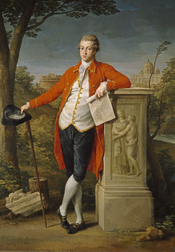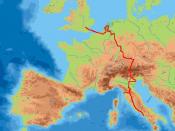Discuss the continuities in the history of youth travel from the Grand Tour to the gap year.
The conventional view of tourism's past is dominated by the history of western cultural experience. It can be traced back to the eighteenth century Grand Tour of extended travel of young men from the aristocratic classes of the United Kingdom and other parts of northern Europe to continental Europe for educational and cultural purposes Towner, 1996, which, suggested that tourism starts with the wealthy, with images of prestigious visits, Grand Tours and time and wealth consuming activities (Towner, 1995, p. 339). During the famous grand tour, greater proportion of aristocratic young men enjoyed the grand tour, and the average length of the return journey was one to two years, with servants and a tutor (French et al, 1997, p. 37).
Withey (1998, p. 3) describes the grand tours as a ÃÂrite of passage intended to supplement a young manÃÂs formal education and provide him with some experience of the worldÃÂ.
Young men would visit museums, learn languages and acquire an appreciation of painting, architecture, history and music (Dickman, 1989, p. 4). Grand tour was the symbolic for wealthy and aristocratic European families, who have had enough discretionary income and time to travel. Nevertheless, grand tour provided younger travelers with the opportunities to become fully educated members of elite society. Therefore, grand tour regularly referred as the educational nature of travel. OÃÂReilly (2006, p. 1004) supported this claim that Grand Tour considered certain experiences to be educational and character forming, making for a more cultured individual.
Grand tour has contributed significantly to the tradition of youthful travel. In contrast with grand tour, tramping has also served as a ritual aid in accomplishing the separation from home and family required by Western styles of adulthood (Adlder, 1985, p. 337). Unlike the grand tour to provide educational opportunities, tramping was linked more explicitly to an early stage of occupational life, journeymen being required to travel for several years before being certified as masters in their craft (Adlder, 1985, p. 339). When people regard tramping as a rite of passage into adulthood, yet, the tramping was primarily responsed to the problem of unemployment, and though young men were more likely than older ones to tramp when local demand for labor diminished, tramping was not limited to youth alone (Adlder, 1985, p. 339). Nonetheless, tramping always had touristic components, young men were motivated not only by the search for work but also by a desire for sightseeing and adventure.
In the 1960s and 1970s, affluent youth, also known as drifters travelled the world (Cohen, 1973). In contrast with grand tour and tramping, Cohen (1972) argued that the drifter has least contact with the tourism industry, has no fixed itinerary or timetable, travels on a more limited budget, and is more of a risk-taker. Drifters are young people who run away from materialistic societies to where they believe can search for the truth of philosophies. They believed that their travels were a rite of passage into the next stage of their lives (Chappel, 2008, p. 40). Cohen in his study (1973) described drifter as vulnerary tramps from middle or upper classes families- unpatriotic and escapist, they commonly beg, scavenge, and share food and lodgings.
After 70s, drifter appeared to have declined with the phenomenon of growth of long-term international budget tourism in the 80s (OÃÂReilly, 2006, p. 1005). Meanwhile, young people are widely accepted rite of passage associating with ideals of freedom, personal development, fulfillment, and part of their education (2006, p. 998). Younger people are more willing to accept backpacker label, and take a long-term, lower budgeted serendipity travelling after study, known as ÃÂgap yearÃÂ (OÃÂReilly, 2006). To some extent, the similarities indicate that backpackers are the inheritors of the drifters. However, todayÃÂs backpackers differ from the original drifters. They are socially constructed, well educated, openness to strangers, willingness to take risks, and would return home for their work.
Youthful backpack could link with Grand Tour, because its focus on gaining education through exposure to different culture. Backpacking has helped younger traveler to developed stronger sense of self-identity. In contrast with tramping, backpacking has shifted from work-related travel to more pure tourism, though, travel can be good for the curriculum vitae in work experience gained on the road and demonstrating qualities that many employers find attractive (OÃÂReilly, 2006, p.1010). Through the backpacking, young people would make contact with others hence establish a network, which would benefit for their future careers and life circles.
In conclusion, grand tour, tramping and drifter tourism has contributed significantly throughout the history of youthful tourism. Grand tour was for the wealthy aristocratic young men who travel for the formal education. Tramping was linked more explicitly to an early stage of occupational life, it would regard as a rite of passage. In contrast with grand tour and tramping, drifter was young escapist run away from materialistic society with no fixed itinerary or timetable, travels on a more limited budget. Nevertheless, they believed that their travels has not different between grand tour and tramping, were a rite of passage into the next stage of their lives. Modem backpacker tourism is the inheritor of drifter, young people undertake long-term and budgeted backpacking tourism in their gap year. However, backpacker is differing from drifter. They are more socially constructed, well educated, believed that backpacking tourism can enhance their social network, benefit for future careers and establish self-identity. Therefore, throughout the history of tourism, the content of tourism evolves dramatically, the context of education and experience will never change.
References:Adler, J 1985, ÃÂYouth on the road: Reflections on the history of trampingÃÂ, Annals of tourism research, vol. 12, no. 3, pp. 335-354.
Chapple, S 2008, Tour 5001: The principles and practices of tourism and hospitality Handout, University of South Australia, AustraliaCohen, E 1972, ÃÂTowards a Sociology of International TourismÃÂ, Social Research, vol. 39, no. 1, pp. 164ÃÂ189.
Cohen, E 1973, ÃÂNomads from affluence: Notes on the phenomenon of drifter-tourismÃÂ, International journal of comparative sociology, vol. XIV, nos. 1-2, pp. 87-103.
Dickman, S 1989, Tourism: An introductory text 3rd ed., Hodder Education, NSW, Australia.
French, CN, Craig-Smith, SJ, Collier, A 1997, Principles of Tourism, LongMan, Mel, AustraliaOÃÂReilly, CC 2006, ÃÂFrom drifter to gap year tourist: Mainstreaming backpacker travelÃÂ, Annals of tourism research, vol. 33, no. 4, pp. 998-1017.
Towner, J 1995, ÃÂWhat is tourism's history?ÃÂ, Tourism Management, Vol. 16, no. 5, pp. 339-343.
Towner, J 1996, An Historical Geography of Recreation and Tourism in the Western World 1540-1940, John Wiley, Chichester, UK.
Withey, L 1998, Grand Tours and CookÃÂs Tours: a history of leisure travel, 1750 to 1915, Aurum Press, London.




